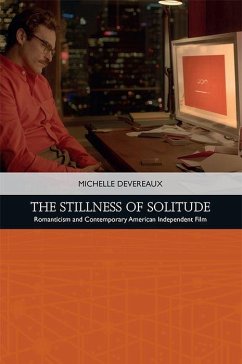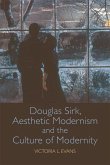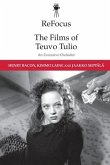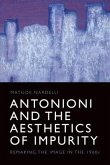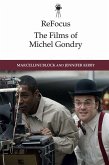- Broschiertes Buch
- Merkliste
- Auf die Merkliste
- Bewerten Bewerten
- Teilen
- Produkt teilen
- Produkterinnerung
- Produkterinnerung
In the first book-length study of Romanticism in relation to American film, Michelle Devereaux takes established theories of contemporary American independent cinema as a point of entry, exploring the underlying philosophical and aesthetic Romantic connections between a selection of seven films from four popular filmmakers: Wes Anderson, Sofia Coppola, Spike Jonze and Charlie Kaufman. Primarily dealing with questions of identity, imagination and the relation between self and world, these films also emphasise the anxieties of our own time: the nostalgia for an imaginary past, and the fear of an…mehr
Andere Kunden interessierten sich auch für
![Douglas Sirk, Aesthetic Modernism and the Culture of Modernity Douglas Sirk, Aesthetic Modernism and the Culture of Modernity]() Victoria L EvansDouglas Sirk, Aesthetic Modernism and the Culture of Modernity30,99 €
Victoria L EvansDouglas Sirk, Aesthetic Modernism and the Culture of Modernity30,99 €![Refocus: The Films of William Friedkin Refocus: The Films of William Friedkin]() Steve ChoeRefocus: The Films of William Friedkin29,99 €
Steve ChoeRefocus: The Films of William Friedkin29,99 €![The Films of Paul Schrader The Films of Paul Schrader]() The Films of Paul Schrader36,99 €
The Films of Paul Schrader36,99 €![Refocus: The Films of Teuvo Tulio Refocus: The Films of Teuvo Tulio]() Henry BaconRefocus: The Films of Teuvo Tulio29,99 €
Henry BaconRefocus: The Films of Teuvo Tulio29,99 €![Antonioni and the Aesthetics of Impurity Antonioni and the Aesthetics of Impurity]() Matilde NardelliAntonioni and the Aesthetics of Impurity29,99 €
Matilde NardelliAntonioni and the Aesthetics of Impurity29,99 €![Refocus: The Films of Michel Gondry Refocus: The Films of Michel Gondry]() Refocus: The Films of Michel Gondry36,99 €
Refocus: The Films of Michel Gondry36,99 €![Refocus: The Films of Albert Brooks Refocus: The Films of Albert Brooks]() Refocus: The Films of Albert Brooks36,99 €
Refocus: The Films of Albert Brooks36,99 €-
-
-
In the first book-length study of Romanticism in relation to American film, Michelle Devereaux takes established theories of contemporary American independent cinema as a point of entry, exploring the underlying philosophical and aesthetic Romantic connections between a selection of seven films from four popular filmmakers: Wes Anderson, Sofia Coppola, Spike Jonze and Charlie Kaufman. Primarily dealing with questions of identity, imagination and the relation between self and world, these films also emphasise the anxieties of our own time: the nostalgia for an imaginary past, and the fear of an uncertain future. Michelle Devereaux is a film journalist and scholar. She received her doctorate in Film Studies from the University of Edinburgh and has taught film theory, history and criticism at the University of Edinburgh and the University of Birmingham.
Produktdetails
- Produktdetails
- Verlag: Edinburgh University Press
- Seitenzahl: 224
- Erscheinungstermin: 26. Mai 2021
- Englisch
- Abmessung: 234mm x 156mm x 12mm
- Gewicht: 322g
- ISBN-13: 9781474446051
- ISBN-10: 1474446051
- Artikelnr.: 59994379
- Herstellerkennzeichnung
- Libri GmbH
- Europaallee 1
- 36244 Bad Hersfeld
- gpsr@libri.de
- Verlag: Edinburgh University Press
- Seitenzahl: 224
- Erscheinungstermin: 26. Mai 2021
- Englisch
- Abmessung: 234mm x 156mm x 12mm
- Gewicht: 322g
- ISBN-13: 9781474446051
- ISBN-10: 1474446051
- Artikelnr.: 59994379
- Herstellerkennzeichnung
- Libri GmbH
- Europaallee 1
- 36244 Bad Hersfeld
- gpsr@libri.de
Michelle Devereaux is a film journalist and scholar. She received her doctorate in Film Studies from the University of Edinburgh and has taught film theory, history and criticism at the University of Edinburgh and the University of Birmingham. She is a board member of intersectional feminist journal on visual culture MAI and currently lives in British Columbia, Canada.
Introduction: Filmmaking as Romantic Quest
What is 'Romantic'?
Imagination and the Romantic Sensibility
Romanticism, Sincerity and Authenticity: A Problem of Identity
'Metamodernism' and Romantic Irony
From the New Wave to New Hollywood to Now
Chapter Overviews
Part I. Romantic Clarity and Confusion
1. Beauty Among the Ruins: The Painful Picturesque and Sentimental Sublime
in Wes Anderson's Aesthetics
The Sublime and the Beautiful in Eighteenth-century Aesthetics
The Royal Tenenbaums and the Painful Picturesque
Trapped in a Never-ending Play: Anderson's Use of Diegetic Space
A Search for Meaning Within Postmodern Pastiche
The Middle-aged Man and the Sea: The Life Aquatic and the Sentimental
Sublime
The Camp Cathedral: Eclecticism in Anderson's Mise-en-scène and Dialogue
Conclusion
2. 'An Endless Succession of Mirrors': Irony, Ambiguity and the Crisis
of Authenticity in Synecdoche, New York
Romantic Irony: From Kant and Schlegel to Byron and Beyond
Embracing Irony and Undermining Realism in Synecdoche, New York
'A Series of Mad Visions Perhaps': The Screen as the Site of Confused
Subjectivity
The Mise en Abyme and the Mathematical Sublime
Conclusion
Part II. Emotion, Imagination and the Feminine Sublime
3. 'Oh! You Pretty Things: The Egotistical and Feminine Sublimes in Sofia
Coppola's The Virgin Suicides
Gendered Expressions of Sublimity: The Egotistical and Feminine Sublimes
Staging Sublimity in Seventies Suburbia
Mood Creation and the 'Emotional Core' of the Film
The Aesthetics and Politics of 'Pretty'
'Preparing to Give Assault': Creating the 'Pseudo-political' gothic
Conclusion
4. Girlfriend in the Machine: Intersubjectivity and the Sublime Limits of
Representation in Spike Jonze's Her
The Role of Will in the Romantic Imagination
Sublime Obscurity and the Mind's Eye
Photographing Sound in a Disembodied Mise-en-scène
'The Light of Sense Goes Out': Intersubjectivity and the Acknowledgment of
Others Conclusion
Part III. Childhood, (R)evolution and Imaginary History
5. 'Because I'm a Wild Animal' : Nature Versus Nurture in Fantastic Mr Fox
Romantic Conceptions of Childhood and Nature
Digging for the Middle Ground: Fantastic Mr Fox and American Pastoralism
'A Native Blend of Myth and Reality': The Landscape of Imagination
Little Savages in the Garden: Ash, Kristofferson and the Romantic Child
Mourning the Loss of Animal Nature
Conclusion
6. 'It's Not Too Much, Is It?' Keats, Fancy and the Ethics
of Pleasurable Excess in Marie Antoinette
Fancy and Material Excess as Alternative Romantic Discourse
Marie Antoinette and the 'Material Sublime'
The 'Romantic Ethic, Daydreaming and Modern Consumption
Revolution, Modernity and Shifting Personal Identities
'Like a Little Piece of Cake': The Body, Consumption and Moral Utility
'Dying into Life': Embracing the Romantic Depth Model?
Conclusion
Conclusion: On Endings and New Beginnings
The Romantic Relationship to Reality: A Questioning of Absolutes
The Battle Between Self-consciousness and Solipsism
'Bravery in the Midst of Indeterminacy': Emotion as a Form of Revolution
List of Works Cited
Index
What is 'Romantic'?
Imagination and the Romantic Sensibility
Romanticism, Sincerity and Authenticity: A Problem of Identity
'Metamodernism' and Romantic Irony
From the New Wave to New Hollywood to Now
Chapter Overviews
Part I. Romantic Clarity and Confusion
1. Beauty Among the Ruins: The Painful Picturesque and Sentimental Sublime
in Wes Anderson's Aesthetics
The Sublime and the Beautiful in Eighteenth-century Aesthetics
The Royal Tenenbaums and the Painful Picturesque
Trapped in a Never-ending Play: Anderson's Use of Diegetic Space
A Search for Meaning Within Postmodern Pastiche
The Middle-aged Man and the Sea: The Life Aquatic and the Sentimental
Sublime
The Camp Cathedral: Eclecticism in Anderson's Mise-en-scène and Dialogue
Conclusion
2. 'An Endless Succession of Mirrors': Irony, Ambiguity and the Crisis
of Authenticity in Synecdoche, New York
Romantic Irony: From Kant and Schlegel to Byron and Beyond
Embracing Irony and Undermining Realism in Synecdoche, New York
'A Series of Mad Visions Perhaps': The Screen as the Site of Confused
Subjectivity
The Mise en Abyme and the Mathematical Sublime
Conclusion
Part II. Emotion, Imagination and the Feminine Sublime
3. 'Oh! You Pretty Things: The Egotistical and Feminine Sublimes in Sofia
Coppola's The Virgin Suicides
Gendered Expressions of Sublimity: The Egotistical and Feminine Sublimes
Staging Sublimity in Seventies Suburbia
Mood Creation and the 'Emotional Core' of the Film
The Aesthetics and Politics of 'Pretty'
'Preparing to Give Assault': Creating the 'Pseudo-political' gothic
Conclusion
4. Girlfriend in the Machine: Intersubjectivity and the Sublime Limits of
Representation in Spike Jonze's Her
The Role of Will in the Romantic Imagination
Sublime Obscurity and the Mind's Eye
Photographing Sound in a Disembodied Mise-en-scène
'The Light of Sense Goes Out': Intersubjectivity and the Acknowledgment of
Others Conclusion
Part III. Childhood, (R)evolution and Imaginary History
5. 'Because I'm a Wild Animal' : Nature Versus Nurture in Fantastic Mr Fox
Romantic Conceptions of Childhood and Nature
Digging for the Middle Ground: Fantastic Mr Fox and American Pastoralism
'A Native Blend of Myth and Reality': The Landscape of Imagination
Little Savages in the Garden: Ash, Kristofferson and the Romantic Child
Mourning the Loss of Animal Nature
Conclusion
6. 'It's Not Too Much, Is It?' Keats, Fancy and the Ethics
of Pleasurable Excess in Marie Antoinette
Fancy and Material Excess as Alternative Romantic Discourse
Marie Antoinette and the 'Material Sublime'
The 'Romantic Ethic, Daydreaming and Modern Consumption
Revolution, Modernity and Shifting Personal Identities
'Like a Little Piece of Cake': The Body, Consumption and Moral Utility
'Dying into Life': Embracing the Romantic Depth Model?
Conclusion
Conclusion: On Endings and New Beginnings
The Romantic Relationship to Reality: A Questioning of Absolutes
The Battle Between Self-consciousness and Solipsism
'Bravery in the Midst of Indeterminacy': Emotion as a Form of Revolution
List of Works Cited
Index
Introduction: Filmmaking as Romantic Quest
What is 'Romantic'?
Imagination and the Romantic Sensibility
Romanticism, Sincerity and Authenticity: A Problem of Identity
'Metamodernism' and Romantic Irony
From the New Wave to New Hollywood to Now
Chapter Overviews
Part I. Romantic Clarity and Confusion
1. Beauty Among the Ruins: The Painful Picturesque and Sentimental Sublime
in Wes Anderson's Aesthetics
The Sublime and the Beautiful in Eighteenth-century Aesthetics
The Royal Tenenbaums and the Painful Picturesque
Trapped in a Never-ending Play: Anderson's Use of Diegetic Space
A Search for Meaning Within Postmodern Pastiche
The Middle-aged Man and the Sea: The Life Aquatic and the Sentimental
Sublime
The Camp Cathedral: Eclecticism in Anderson's Mise-en-scène and Dialogue
Conclusion
2. 'An Endless Succession of Mirrors': Irony, Ambiguity and the Crisis
of Authenticity in Synecdoche, New York
Romantic Irony: From Kant and Schlegel to Byron and Beyond
Embracing Irony and Undermining Realism in Synecdoche, New York
'A Series of Mad Visions Perhaps': The Screen as the Site of Confused
Subjectivity
The Mise en Abyme and the Mathematical Sublime
Conclusion
Part II. Emotion, Imagination and the Feminine Sublime
3. 'Oh! You Pretty Things: The Egotistical and Feminine Sublimes in Sofia
Coppola's The Virgin Suicides
Gendered Expressions of Sublimity: The Egotistical and Feminine Sublimes
Staging Sublimity in Seventies Suburbia
Mood Creation and the 'Emotional Core' of the Film
The Aesthetics and Politics of 'Pretty'
'Preparing to Give Assault': Creating the 'Pseudo-political' gothic
Conclusion
4. Girlfriend in the Machine: Intersubjectivity and the Sublime Limits of
Representation in Spike Jonze's Her
The Role of Will in the Romantic Imagination
Sublime Obscurity and the Mind's Eye
Photographing Sound in a Disembodied Mise-en-scène
'The Light of Sense Goes Out': Intersubjectivity and the Acknowledgment of
Others Conclusion
Part III. Childhood, (R)evolution and Imaginary History
5. 'Because I'm a Wild Animal' : Nature Versus Nurture in Fantastic Mr Fox
Romantic Conceptions of Childhood and Nature
Digging for the Middle Ground: Fantastic Mr Fox and American Pastoralism
'A Native Blend of Myth and Reality': The Landscape of Imagination
Little Savages in the Garden: Ash, Kristofferson and the Romantic Child
Mourning the Loss of Animal Nature
Conclusion
6. 'It's Not Too Much, Is It?' Keats, Fancy and the Ethics
of Pleasurable Excess in Marie Antoinette
Fancy and Material Excess as Alternative Romantic Discourse
Marie Antoinette and the 'Material Sublime'
The 'Romantic Ethic, Daydreaming and Modern Consumption
Revolution, Modernity and Shifting Personal Identities
'Like a Little Piece of Cake': The Body, Consumption and Moral Utility
'Dying into Life': Embracing the Romantic Depth Model?
Conclusion
Conclusion: On Endings and New Beginnings
The Romantic Relationship to Reality: A Questioning of Absolutes
The Battle Between Self-consciousness and Solipsism
'Bravery in the Midst of Indeterminacy': Emotion as a Form of Revolution
List of Works Cited
Index
What is 'Romantic'?
Imagination and the Romantic Sensibility
Romanticism, Sincerity and Authenticity: A Problem of Identity
'Metamodernism' and Romantic Irony
From the New Wave to New Hollywood to Now
Chapter Overviews
Part I. Romantic Clarity and Confusion
1. Beauty Among the Ruins: The Painful Picturesque and Sentimental Sublime
in Wes Anderson's Aesthetics
The Sublime and the Beautiful in Eighteenth-century Aesthetics
The Royal Tenenbaums and the Painful Picturesque
Trapped in a Never-ending Play: Anderson's Use of Diegetic Space
A Search for Meaning Within Postmodern Pastiche
The Middle-aged Man and the Sea: The Life Aquatic and the Sentimental
Sublime
The Camp Cathedral: Eclecticism in Anderson's Mise-en-scène and Dialogue
Conclusion
2. 'An Endless Succession of Mirrors': Irony, Ambiguity and the Crisis
of Authenticity in Synecdoche, New York
Romantic Irony: From Kant and Schlegel to Byron and Beyond
Embracing Irony and Undermining Realism in Synecdoche, New York
'A Series of Mad Visions Perhaps': The Screen as the Site of Confused
Subjectivity
The Mise en Abyme and the Mathematical Sublime
Conclusion
Part II. Emotion, Imagination and the Feminine Sublime
3. 'Oh! You Pretty Things: The Egotistical and Feminine Sublimes in Sofia
Coppola's The Virgin Suicides
Gendered Expressions of Sublimity: The Egotistical and Feminine Sublimes
Staging Sublimity in Seventies Suburbia
Mood Creation and the 'Emotional Core' of the Film
The Aesthetics and Politics of 'Pretty'
'Preparing to Give Assault': Creating the 'Pseudo-political' gothic
Conclusion
4. Girlfriend in the Machine: Intersubjectivity and the Sublime Limits of
Representation in Spike Jonze's Her
The Role of Will in the Romantic Imagination
Sublime Obscurity and the Mind's Eye
Photographing Sound in a Disembodied Mise-en-scène
'The Light of Sense Goes Out': Intersubjectivity and the Acknowledgment of
Others Conclusion
Part III. Childhood, (R)evolution and Imaginary History
5. 'Because I'm a Wild Animal' : Nature Versus Nurture in Fantastic Mr Fox
Romantic Conceptions of Childhood and Nature
Digging for the Middle Ground: Fantastic Mr Fox and American Pastoralism
'A Native Blend of Myth and Reality': The Landscape of Imagination
Little Savages in the Garden: Ash, Kristofferson and the Romantic Child
Mourning the Loss of Animal Nature
Conclusion
6. 'It's Not Too Much, Is It?' Keats, Fancy and the Ethics
of Pleasurable Excess in Marie Antoinette
Fancy and Material Excess as Alternative Romantic Discourse
Marie Antoinette and the 'Material Sublime'
The 'Romantic Ethic, Daydreaming and Modern Consumption
Revolution, Modernity and Shifting Personal Identities
'Like a Little Piece of Cake': The Body, Consumption and Moral Utility
'Dying into Life': Embracing the Romantic Depth Model?
Conclusion
Conclusion: On Endings and New Beginnings
The Romantic Relationship to Reality: A Questioning of Absolutes
The Battle Between Self-consciousness and Solipsism
'Bravery in the Midst of Indeterminacy': Emotion as a Form of Revolution
List of Works Cited
Index

